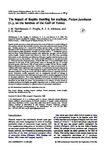The impact of Rapido trawling for scallops,Pecten jacobaeus(L.), on the benthos of the Gulf of Venice
| dc.contributor.author | Hall-Spencer, Jason | |
| dc.date.accessioned | 2013-02-20T12:26:31Z | |
| dc.date.available | 2013-02-20T12:26:31Z | |
| dc.date.issued | 1999-02 | |
| dc.identifier.issn | 1054-3139 | |
| dc.identifier.issn | 1095-9289 | |
| dc.identifier.uri | http://hdl.handle.net/10026.1/1366 | |
| dc.description.abstract |
Rapido trawls are used to catch sole around the coast of Italy and to catch scallops in the northern Adriatic Sea but little is known about the environmental impact of this gear. Benthic surveys of a commercial scallop ground using a towed underwater television (UWTV) sledge revealed an expansive area of level, sandy sediment at 25 m characterized by high population densities of scallops (2.82 m-2 Aequipecten opercularis but fewer Pecten jacobaeus) together with ophiuroids, sponges, and the bivalve Atrina fragilis. Rapido trawls were filmed in action for the first time, providing information on the selectivity and efficiency of the gear together with its impact on the substratum and on the benthos. The trawls worked efficiently on smooth sand with ca. 44% catch rate for Pecten jacobaeus, of which 90% were >7 cm in shell height. Most organisms in the path of the trawl passed under or through the net; on average by-catch species only formed 19% of total catch by weight. Of the 78 taxa caught, lethal mechanical damage varied from <10% in resilient taxa such as hermit crabs to >50% in soft-bodied organisms such as tunicates. A marked plot surveyed using towed UWTV before, then 1 and 15 h after fishing by Rapido trawl showed clear tracks of disturbed sediment along the trawl path where infaunal burrow openings had been erased. Abundant, motile organisms such as Aequipecten showed no change in abundance along these tracks although scavengers such as Inachus aggregated to feed on damaged organisms. There were significant decreases in the abundance of slow-moving/sessile benthos such as Pecten, Holothuria, and Atrina. Juvenile pectinids were abundant on the shells of Atrina. The introduction of a scheme of areas closed to trawling would protect highly susceptible organisms such as Atrina and enhance the chances of scallop recruitment to adjacent areas of commercial exploitation. | |
| dc.format.extent | 111-124 | |
| dc.language | en | |
| dc.language.iso | en | |
| dc.publisher | Oxford University Press (OUP) | |
| dc.subject | fishing | |
| dc.subject | trawling impact | |
| dc.subject | scallops | |
| dc.subject | Pecten jacobaeus | |
| dc.subject | Atrina fragilis | |
| dc.subject | Adriatic Sea | |
| dc.subject | Mediterranean Sea | |
| dc.title | The impact of Rapido trawling for scallops,Pecten jacobaeus(L.), on the benthos of the Gulf of Venice | |
| dc.type | journal-article | |
| dc.type | Journal Article | |
| plymouth.author-url | https://www.webofscience.com/api/gateway?GWVersion=2&SrcApp=PARTNER_APP&SrcAuth=LinksAMR&KeyUT=WOS:000079024000011&DestLinkType=FullRecord&DestApp=ALL_WOS&UsrCustomerID=11bb513d99f797142bcfeffcc58ea008 | |
| plymouth.issue | 1 | |
| plymouth.volume | 56 | |
| plymouth.publication-status | Published | |
| plymouth.journal | ICES Journal of Marine Science | |
| dc.identifier.doi | 10.1006/jmsc.1998.0424 | |
| plymouth.organisational-group | /Plymouth | |
| plymouth.organisational-group | /Plymouth/Faculty of Science and Engineering | |
| plymouth.organisational-group | /Plymouth/Faculty of Science and Engineering/School of Biological and Marine Sciences | |
| plymouth.organisational-group | /Plymouth/PRIMaRE Publications | |
| plymouth.organisational-group | /Plymouth/REF 2021 Researchers by UoA | |
| plymouth.organisational-group | /Plymouth/REF 2021 Researchers by UoA/UoA07 Earth Systems and Environmental Sciences | |
| plymouth.organisational-group | /Plymouth/Research Groups | |
| plymouth.organisational-group | /Plymouth/Research Groups/Marine Institute | |
| plymouth.organisational-group | /Plymouth/Users by role | |
| plymouth.organisational-group | /Plymouth/Users by role/Academics | |
| dc.identifier.eissn | 1095-9289 | |
| dc.rights.embargoperiod | Not known | |
| rioxxterms.versionofrecord | 10.1006/jmsc.1998.0424 | |
| rioxxterms.licenseref.uri | http://www.rioxx.net/licenses/all-rights-reserved | |
| rioxxterms.type | Journal Article/Review |


